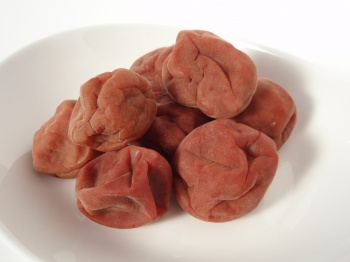Difference between revisions of "Umeboshi"
(→Special Precautions of Umeboshi) |
(→Special Precautions of Umeboshi) |
||
| Line 2: | Line 2: | ||
Umeboshi (Japanese: 梅干) are pickled ume fruits common in Japan. The word "umeboshi" is often translated into English as "Japanese salt plums," "salt plums" or "pickled plums." Ume (Prunus mume) is a species of fruit-bearing tree in the genus Prunus, which is often called a plum but is actually more closely related to the apricot. Umeboshi are a popular kind of tsukemono (pickles) and are extremely sour and salty. They are usually served as side dishes for rice or eaten on rice balls (often without removing the pit) for breakfast and lunch. They are occasionally served boiled or seasoned for dinner. | Umeboshi (Japanese: 梅干) are pickled ume fruits common in Japan. The word "umeboshi" is often translated into English as "Japanese salt plums," "salt plums" or "pickled plums." Ume (Prunus mume) is a species of fruit-bearing tree in the genus Prunus, which is often called a plum but is actually more closely related to the apricot. Umeboshi are a popular kind of tsukemono (pickles) and are extremely sour and salty. They are usually served as side dishes for rice or eaten on rice balls (often without removing the pit) for breakfast and lunch. They are occasionally served boiled or seasoned for dinner. | ||
==Special Precautions of Umeboshi== | ==Special Precautions of Umeboshi== | ||
| − | * | + | *The seeds and flesh of ume contain cyanogenetic glycoside, which is a compound of sugars and hydrocyanic acid, and when consumed, it may cause, among others, difficulty of breathing, dizziness, spasms, and even paralysis. |
| − | * | + | *The amount of cyanogenetic glycoside contained in a green ume plum is very limited, though, so there is only risk of serious, adverse side-effects if an adult consumes 300 ping-pong ball-sized ume plums, or a child consumes 100 ume plums, in one sitting. |
| + | *However, you need to take extra care when eating young, unripen green plums taken from trees, because the seeds contain 10-20 times as much cyanogenetic glycoside as the flesh. Do not eat soft green plums taken from trees whole, with the seeds still in them. For safe eating, ume plums need to be heated, pickled or dried so that toxic cyanogenetic glycoside is destroyed. | ||
==Benefits and uses of Umeboshi are== | ==Benefits and uses of Umeboshi are== | ||
Latest revision as of 13:20, 9 June 2024
Umeboshi (Japanese: 梅干) are pickled ume fruits common in Japan. The word "umeboshi" is often translated into English as "Japanese salt plums," "salt plums" or "pickled plums." Ume (Prunus mume) is a species of fruit-bearing tree in the genus Prunus, which is often called a plum but is actually more closely related to the apricot. Umeboshi are a popular kind of tsukemono (pickles) and are extremely sour and salty. They are usually served as side dishes for rice or eaten on rice balls (often without removing the pit) for breakfast and lunch. They are occasionally served boiled or seasoned for dinner.
Special Precautions of Umeboshi
- The seeds and flesh of ume contain cyanogenetic glycoside, which is a compound of sugars and hydrocyanic acid, and when consumed, it may cause, among others, difficulty of breathing, dizziness, spasms, and even paralysis.
- The amount of cyanogenetic glycoside contained in a green ume plum is very limited, though, so there is only risk of serious, adverse side-effects if an adult consumes 300 ping-pong ball-sized ume plums, or a child consumes 100 ume plums, in one sitting.
- However, you need to take extra care when eating young, unripen green plums taken from trees, because the seeds contain 10-20 times as much cyanogenetic glycoside as the flesh. Do not eat soft green plums taken from trees whole, with the seeds still in them. For safe eating, ume plums need to be heated, pickled or dried so that toxic cyanogenetic glycoside is destroyed.
Benefits and uses of Umeboshi are
This Japanese style traditional pickle is considered good for digestion, prevention of nausea, and for systemic toxicity, including hangovers. Green ume extract is even used as a tonic in Japan. The citric acid is claimed to act as an antibacterial, help to increase saliva production and assist in the digestion of rice. Additionally, umeboshi is claimed to combat fatigue (historically given as part of a samurai's field ration) and protect against aging.
- Gallbladder attacks resulting from food intolerance
- Stomach upset, as well as morning sickness and motion sickness
- Hangover by more efficiently metabolizing alcohol
- Food poisoning, diarrhea and constipation
- Fatigue by fighting the effects of acid produced during physical activity
- Bowel discomfort caused by intestinal worms, fungi and bad gut bacteria
- Food intolerance, which often leads to other digestive conditions
- Acid/alkaline balance : alkaline fruit has been shown to help balance the acid in your body – acid imbalance is a common problem among vegetarians who consume high levels of grains and nuts. - See
- Antioxidant – fights the negative effects of oxidation
- Antibiotic – inhibits the growth of bacteria
- Antiseptic – prevents infection
- Anti-diarrheal – prevents and/or stops all forms of diarrhea
- Anthelmintic – expels intestinal worms
- Anti-typhoid – fights fever
- Tuberculosis : New York University discovered in 1890 that the citric and malic acids found in umeboshi were effective in the prevention of tuberculosis – a bacterial infection that starts in the lungs and can quickly spread throughout the body.
